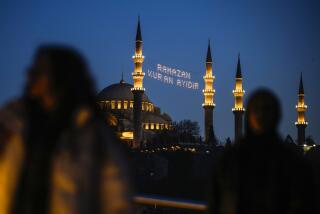Social, religious divide on display in attack on Turkish art walk
- Share via
Reporting from Istanbul, Turkey — It was meant to be a celebration of high art and the bohemian spirit of a city that has been designated by the European Union as a European Cultural Capital of 2010. Instead, a controversial art exhibit last week turned into a violent neighborhood melee that made national news.
FOR THE RECORD:
Turkish art walk attack: An article in the Sept. 27 Section A about violence at an art opening in Istanbul incorrectly referred to the Tophane Art Walk as the Tophane Art Work. —
As art lovers drank sangria out of plastic cups and contemplated iconoclastic pieces of art that deconstructed Turkey’s 20th century history, a group of local toughs in the central Istanbul neighborhood of Tophane attacked them with pepper gas and frozen oranges. For an hour, they smashed windows and injured dozens, including visiting foreigners.
None of the artwork was damaged, and the galleries quickly reopened. But the riot remains the talk of the town, and the victims are scheduled to meet Monday with a lawyer to consider possible legal action.
“We were so happy because for the first time an art event was crowded,” said Derya Demir, the 30-year-old owner of the Non Gallery, where the chaos erupted Tuesday. “There was no warning at all.” The gallery was one of several participating in the Tophane Art Walk, a weeks-long presentation of new work by underground local artists amid heightened interest in contemporary Middle East art.
The incident highlighted class and social cleavages between Turkey’s European-oriented wealthy urban elite and religious conservatives with strong roots in the country’s rural Anatolia region. It was also a case of urban friction in a rapidly gentrifying district where working-class people are being driven out by wealthier and highly educated arrivals.
Prime Minister Recep Tayyip Erdogan, whose political party is rooted in Turkey’s Islamic movements, weighed in, downplaying the attack. “Such incidents occur everywhere in the world,” he said. “There is no reason to exaggerate those incidents.”
Some residents blamed the gallery owners and guests for drinking alcohol in public in violation of Islamic law. In central Istanbul, pockets of conservative Islam coexist with freewheeling outdoor cafes, bars and dance clubs. But residents complained that the gallery owners were pushing the envelope by allowing patrons to drink outside in a residential area that has long been home to observant Muslim families.
“The galleries’ existence here is a good thing,” said Mehmet Sahin, a 35-year-old grocery store owner. “But the gallery people are provoking people.”
Demir dismissed such criticism. She said she refrained from serving guests bottles of beer or glasses of wine and deliberately served alcoholic drinks in plastic cups out of sensitivity for the neighborhood’s values. Yet even after police arrived, assailants continued to pursue the traumatized guests.
They even struck an 80-year-old man, Demir said, the grandfather of an artist’s assistant. He had come to see the artworks, which included a statue of Kemal Ataturk, founder of the Turkish republic, depicted as a fallen angel.
The gallery owner said she sees the attack as part of a systematic effort by a small group of neighborhood toughs to intimidate those who don’t share their values. She and others said that over the summer some residents had warned in Internet postings that they would wreak havoc during the art walk.
Some analysts and Turkish media attributed the violence to a fear of rising rents pushing old-timers out of the neighborhood. But some note that most of the people living in the tenements are from families that squatted homes once belonging to middle-class Greeks deported from Istanbul in a wave of “ethnic cleansing” in 1964.
“Who is a local is a big question,” said Sinem Yoruk, owner of another nearby gallery that came under attack.
But even some intellectuals who were at the opening and had to dodge the projectiles found themselves sympathizing a bit with the assailants.
“The attackers were the underdogs,” said Cengiz Aktar, a newspaper columnist and social scientist at Bahcesehir University in Istanbul, who is friends with the gallery owner. “This area will be gentrified. The slums will be cleared. These guys will have to leave, and they know it and are upset about it.”
daragahi@latimes.com
More to Read
Sign up for Essential California
The most important California stories and recommendations in your inbox every morning.
You may occasionally receive promotional content from the Los Angeles Times.













